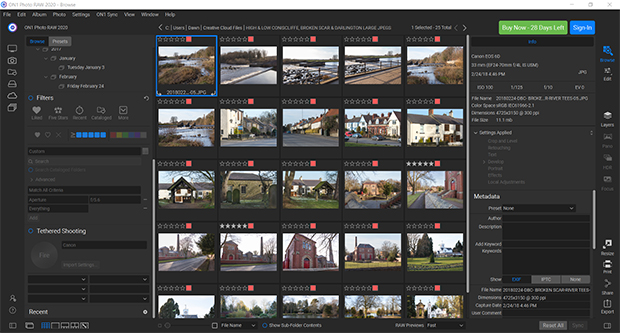
- #On1 photo raw full screen mode how to#
- #On1 photo raw full screen mode full#
- #On1 photo raw full screen mode iso#
#On1 photo raw full screen mode full#
Toggle the backslash or back slash (\) key to see the before and after preview in full view. Zoom in to 1:1 or even 2:1 on the image so we can actually see the difference while adjusting the Amount from 25 to 50, 75 or 100. Then we can copy all of our previous Develop settings onto the Before preview to comparably see the difference. You want to be connected directly to your Raw, or original, file. Something to consider with sharpening is we have to see the image at 100%, so working with a Smart Preview will be an issue. You’ll notice the Amount slider is defaulted at 25, Radius at 1.0, Detail at 25 and Masking at 0. In the event you have a lot of noise in the image you are sharpening, you can read my previous Shutter Magazine article “ Silence the Noise” for additional support.
#On1 photo raw full screen mode iso#
For this particular image, we do not need any Noise Reduction since it was shot at ISO 50 and properly exposed for. We basically have three sections in the Detail panel: Sharpening, Noise Reduction Luminance and Noise Color. Again, this is completely subjective but will help keep things in check. I recommend removing all the fluff settings in camera for a more faithful representation of your image. This panel is going to bring back details you saw on the back of your camera. At this stage, we are going to simply bring back the sharpness to the Raw file.

Once we have our image prepped and ready to sharpen in Lightroom, we can navigate to the Detail panel and implement Input Sharpening. I will be working strictly in Lightroom and ON to demonstrate a complete Raw workflow.
#On1 photo raw full screen mode how to#
Knowing when and how to get the most out of sharpening is where I am going to focus in this article. There are different processes and programs we can use to sharpen our images. That’s where editing programs can save the image and bring back the sharpness you intended to capture. Even with full-frame digital cameras and the best glass, there is a chance for failure. The biggest fear when shooting is losing the peak focus on the subject’s eye and having an unusable image because you shot them at such a thin aperture. This is only the first step in the process as we ingest our Raw images to see how sharp the subject is.

In an image where removing the person from the frame would give you an amazing landscape, you have to push your technical skills to keep the focus on the portrait. Many of us consider shooting wide open to draw the viewer immediately to the main subject, typically the person standing in the field, so to speak. We look for the eye of the subject, dial in the exposure settings and fire away.

When photographing people in a landscape, it is so important to push the limits of your lens to capture detail. Image Sharpening: A Complete Raw Workflow with Lightroom and ON1 Photo RAW 2018 with Dustin Lucas


 0 kommentar(er)
0 kommentar(er)
